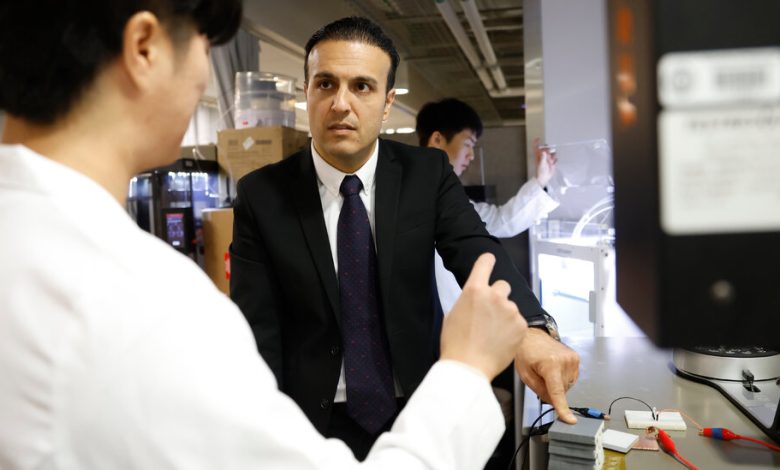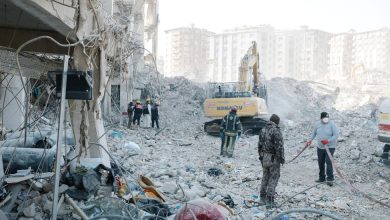New Tool for Building and Fixing Roads and Bridges: Artificial Intelligence

In Pennsylvania, where 13 percent of the bridges have been classified as structurally deficient, engineers are using artificial intelligence to create lighter concrete blocks for new construction. Another project is using A.I. to develop a highway wall that can absorb noise from cars — and some of the greenhouse gas emissions that traffic releases as well.
At a time when the federal allocation of billions of dollars toward infrastructure projects would help with only a fraction of the cost needed to repair or replace the nation’s aging bridges, tunnels, buildings and roads, some engineers are looking to A.I. to help build more resilient projects for less money.
“These are structures, with the tools that we have, that save materials, save costs, save everything,” said Amir Alavi, an engineering professor at the University of Pittsburgh and a member of the consortium developing the two A.I. projects in conjunction with the Pennsylvania Department of Transportation and the Pennsylvania Turnpike Commission.
The potential is enormous. The manufacturing of cement alone makes up at least 8 percent of the world’s carbon emissions, and 30 billion tons of concrete are used worldwide each year, so more efficient production of concrete would have immense environmental implications.
And A.I. — essentially machines that can synthesize information and find patterns and conclusions much as the human mind can — could have the ability to speed up and improve tasks like engineering challenges to an incalculable degree. It works by analyzing vast amounts of data and offering options that give humans better information, models and alternatives for making decisions.
It has the potential to be both more cost effective — one machine doing the work of dozens of engineers — and more creative in coming up with new approaches to familiar tasks.
But experts caution against embracing the technology too quickly when it is largely unregulated and its payoffs remain largely unproven. In particular, some worry about A.I.’s ability to design infrastructure in a process with several regulators and participants operating over a long period of time. Others worry that A.I.’s ability to draw instantly from the entirety of the internet could lead to flawed data that produces unreliable results.
American infrastructure challenges have become all the more apparent in recent years — Texas’ power grid failed during devastating ice storms in 2021 and continues to grapple with the state’s needs; communities across the country from Flint, Mich., to Jackson, Miss., have struggled with failing water supplies; and more than 42,000 bridges are in poor condition nationwide.
A vast majority of the country’s roadways and bridges were built several decades ago, and as a result “infrastructure challenges are significant in many dimensions,” said Abdollah Shafieezadeh, a professor of civil, environmental and geodetic engineering at Ohio State University.
The collaborations in Pennsylvania reflect A.I.’s potential to address some of these issues.
In the bridge project, engineers are using A.I. technology to develop new shapes for concrete blocks that use 20 percent less material while maintaining durability. The Pennsylvania Department of Transportation will use the blocks to construct a bridge; there are more than 12,000 in the state that need repair, according to the American Road & Transportation Builders Association.
Engineers in Pittsburgh are also working with the Pennsylvania Turnpike Commission to design a more efficient noise-absorbing wall that will also capture some of the nitrous oxide emitted from vehicles. They are planning to build it in an area that is disproportionately affected by highway sound pollution. The designs will save about 30 percent of material costs.
These new projects have not been tested in the field, but they have been successful in the lab environment, Dr. Alavi said.
In addition to A.I.’s speed at developing new designs, one of its largest draws in civil engineering is its potential to prevent and detect damage.
Instead of investing large sums of money in repair projects, engineers and transportation agencies could identify problems early on, experts say, such as a crack forming in a bridge before the structure itself buckled.
This technology is capable of providing an analysis of what is happening in real time in incidents like the bridge collapse on Interstate 95 in Philadelphia this summer or the fire that shut down a portion of Interstate 10 in Los Angeles this month, and could be developed to deploy automated emergency responses, said Seyede Fatemeh Ghoreishi, an engineering and computer science professor at Northeastern University.
But, as in many fields, there are increasingly more conversations — and concerns — about the relationship between A.I., human work and physical safety.
Although A.I. has proved helpful in many uses, tech leaders have testified before Congress, pushing for regulations. And last month, President Biden issued an executive order for a range of A.I. standards, including safety, privacy and support for workers.
Experts are also worried about the spread of disinformation from A.I. systems. A.I. operates by integrating already available data, so if that data is incorrect or biased, the A.I. will generate faulty conclusions.
“It really is a great tool, but it really is a tool you should use just for a first draft at this point,” said Norma Jean Mattei, a former president of the American Society of Civil Engineers.
Dr. Mattei, who has worked in education and ethics for engineering throughout her career, added: “Once it develops, I’m confident that we’ll get to a point where you’re less likely to get issues. We’re not there yet.”
Also worrisome is a lack of standards for A.I. The Occupational Safety and Health Administration, for example, does not have standards for the robotics industry. There is rising concern about car crashes involving autonomous vehicles, but for now, automakers do not have to abide by any federal software safety testing regulations.
Lola Ben-Alon, an assistant professor of architecture technology at Columbia University, also takes a cautionary approach when using A.I. She stressed the need to take the time to understand how it should be employed, but she said that she was “not condemning it” and that it had many great potentials.
Few doubt that in infrastructure projects and elsewhere, A.I. exists as a tool to be used by humans, not as a substitute for them.
“There’s still a strong and important place for human existence and experience” in the field of engineering, Dr. Ben-Alon said.
The uncertainty around A.I. could cause more difficulties for funding projects like those in Pittsburgh. But a spokesman for the Pennsylvania Department of Transportation said the agency was excited to see how the concrete that Dr. Alavi and his team are designing could expand the field of bridge construction.
Dr. Alavi said his work throughout his career had shown him just how serious the potential risks from A.I. are.
But he is confident about the safety of the designs he and his team are making, and he is excited for the technology’s future.
“After 10, 12 years, this is going to change our lives,” Dr. Alavi said.




